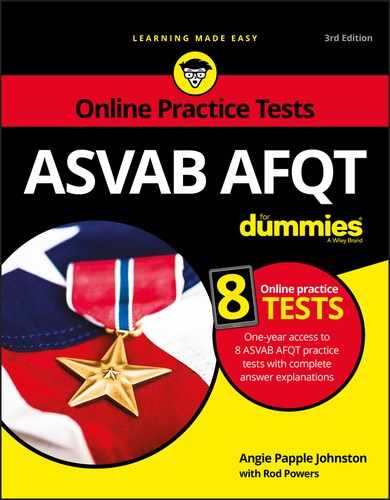Chapter 13
Practice Exam 1
The Armed Forces Qualification Test (AFQT) consists of four of the nine subtests given on the Armed Services Vocational Aptitude Battery (ASVAB). The four subtests used to determine your AFQT score are Arithmetic Reasoning, Word Knowledge, Paragraph Comprehension, and Mathematics Knowledge.
Your AFQT score is very important. Although all the ASVAB subtests are used to determine which military jobs you may qualify for, the AFQT score determines whether you’re even qualified to join the military. All the military service branches have established minimum AFQT scores, according to their needs (see Chapter 2 for more information).
The AFQT is not a stand-alone test (it’s part of the ASVAB), but in this chapter, I present the subtests applicable to the AFQT in the same order in which you’ll encounter them when you take the actual ASVAB.
After you complete the entire practice test, check your answers against the answer key in Chapter 14.
Your goal in taking this practice test is to determine which areas you may still need to study. If you miss only one question on the Word Knowledge subtest, but you miss 15 questions on Arithmetic Reasoning, you probably want to devote some extra study time to developing your math skills before you take the ASVAB.
Answer Sheet for Practice Exam 1
Part 1: Arithmetic Reasoning

Part 2: Word Knowledge

Part 3: Paragraph Comprehension

Part 4: Mathematics Knowledge

Part 1: Arithmetic Reasoning
1. Amy and Dan bought each of their four kids an ice cream cone and one iced coffee for themselves to share. Each ice cream cone cost $1.25, and their total bill was $7.50. How much did the iced coffee cost?
(A) $2.75
(B) $2.50
(C) $1.25
(D) $1.75
2. Sergeant Major Stanley is drawing a map in the sand for his troops. He draws the Tuz Mayor’s Compound as a square measuring 18 inches on one side. What is the area of the square?
(A) 36 square inches
(B) 72 square inches
(C) 324 square inches
(D) 583 square inches
3. Currently, Danielle is twice as old as Abigail. In three years, the sum of their ages will be 30. What is Danielle’s current age?
(A) 16
(B) 14
(C) 10
(D) 8
4. Tammy bought a set of rims for her truck for $500. She spent some money on window tint and twice as much on a new radio. Her total bill for all of these modifications was $950. How much did she spend on the radio?
(A) $300
(B) $325
(C) $150
(D) $450
5. Half a number plus 17 is 57. What is the number?
(A) 20
(B) 90
(C) 80
(D) 40
6. A recipe to make 10 pancakes requires 3 cups of flour and 2 tablespoons of baking powder. If you only need to make six pancakes, how many cups of flour do you need?
(A) ![]() cups
cups
(B) ![]() cups
cups
(C) ![]() cups
cups
(D) ![]() cups
cups
7. Tim and Jason are painting a room. It takes Tim 10 hours to paint a room of that size alone, but Jason can get it done in 8 hours. Approximately how long will it take them to paint the room together?
(A) 4.2 hours
(B) 4.4 hours
(C) 9 hours
(D) 9.4 hours
8. Ebony is building a rectangular garden in her backyard. To fit in everything she wants to grow, she needs a garden with an area of 156 square feet. If her garden is 12 feet long, how wide should it be?
(A) 10 feet
(B) 15.6 feet
(C) 13 feet
(D) 12 feet
9. Two consecutive odd numbers have a sum of 92. What are the numbers?
(A) 41 and 51
(B) 44 and 48
(C) 43 and 45
(D) 45 and 47
10. Davy gets $17 per month in allowance. He saved two months’ worth of allowance and then spent ![]() of it on apps for his phone. He spent
of it on apps for his phone. He spent ![]() of the remaining money on a bumper sticker. Of the money left after purchasing the sticker, Davy spent
of the remaining money on a bumper sticker. Of the money left after purchasing the sticker, Davy spent ![]() of it on candy. How much did Davy spend on the candy?
of it on candy. How much did Davy spend on the candy?
(A) $5.95
(B) $2.85
(C) $1.70
(D) $13.60
11. Three baristas, Pilar, Maria, and Tatiana, made $187 in tips on Saturday. Pilar made $12 more than Maria, and Maria made twice as much as Tatiana. How much did Tatiana make in tips?
(A) $70
(B) $35
(C) $25
(D) $65.50
12. Mr. Brown confiscated a triangle-shaped note from a student during his fourth-period math class. The note’s base was 8 centimeters and its height was 12 centimeters. What was the note’s area?
(A) 48 square inches
(B) 96 square inches
(C) 52 square inches
(D) 32 square inches
13. A car travels at a speed of ![]() miles per hour. If the car travels at that speed for
miles per hour. If the car travels at that speed for ![]() hours, how many miles has the car gone?
hours, how many miles has the car gone?
(A) 112 miles
(B) 392 miles
(C) 594 miles
(D) 784 miles
14. Two runners are racing on a 2-mile course. The start gun fires at 1:15 p.m. The first runner speeds along at an average pace of 10.3 miles per hour, while the second runner travels at a pace of 10 miles per hour. How long does it take for the second runner to reach the finish line?
(A) 12 minutes
(B) 13.3 minutes
(C) 14 minutes
(D) 14.8 minutes
15. A man in a boat travels downstream for three hours. The current averages 4 miles per hour. The man then turns around and travels the same distance upstream, against the current. It takes him four hours to return to his starting point. The boat’s speed is constant the entire trip. How far did the man travel round-trip?
(A) 96 miles
(B) 112 miles
(C) 192 miles
(D) 216 miles
16. Sadie spent $447 shopping for school clothes. Sweatshirts cost $27.50 each, and jeans cost $33.25 per pair. Sadie purchased 15 items of clothing, so how many pairs of jeans did she buy?
(A) 5
(B) 6
(C) 8
(D) 9
17. Luke’s microscope has an objective lens that can magnify something ![]() times. Its eyepiece can further magnify something
times. Its eyepiece can further magnify something ![]() times. What is Luke’s microscope’s maximum magnification?
times. What is Luke’s microscope’s maximum magnification?
(A) ![]()
(B) ![]()
(C) ![]()
(D) ![]()
18. Michael spends $27 on chocolate that costs $4.50 per pound. How many pounds of chocolate did he buy?
(A) 4.5 pounds
(B) 5 pounds
(C) 6 pounds
(D) 6.8 pounds
19. A kite has one diagonal length of 18.5 cm and another diagonal length of twice that. What is the kite’s area?
(A) 111 cm2
(B) 256.75 cm2
(C) 342.25 cm2
(D) 684.5 cm2
20. If the height-to-width ratio of an American flag is 1:1.5, how wide is the flag if it is 60 inches high?
(A) 40 inches
(B) 60 inches
(C) 90 inches
(D) 120 inches
21. The price of a car has increased by 5 percent. It was originally listed for $23,550. What is the current price of the car?
(A) $23,950
(B) $24,323.50
(C) $24,727.50
(D) $31,975
22. If you walk around the outside edge of a field that measures 300 feet by 160 feet and end where you started, how many feet did you walk?
(A) 460 feet
(B) 800 feet
(C) 920 feet
(D) 1,100 feet
23. Carter used all of his quarters at the car wash, but he still has 23 coins in his pocket. Some of them are nickels, and some are dimes, but the total in his pocket is $1.50. How many of the coins are dimes?
(A) 7
(B) 8
(C) 9
(D) 10
24. Tim is building a toy UFO for his daughter. He cuts a circle from a piece of tin with a diameter of 12.5 inches. What is the approximate area of the shape Tim cut?
(A) 78.5 square inches
(B) 115.3 square inches
(C) 122.7 square inches
(D) 490.7 square inches
25. Vicki is packing a suitcase for her vacation. She knows she’ll be picking up a music box as a gift for her friend Danielle. The hand-carved music box measures 8 inches wide, 8 inches high, and 8 inches long. Vicki’s suitcase measures 19 inches wide, 30 inches high, and 10 inches long. How much space will Vicki have left for her clothes if she plans to pack the music box when she comes home?
(A) 5,188 cubic inches
(B) 3,894 cubic inches
(C) 5,700 cubic inches
(D) 6,212 cubic inches
26. How many legs do six horses, four dogs, and two kangaroos have?
(A) 36
(B) 38
(C) 41
(D) 44
27. Chloe is graphing her weight loss, which falls on a line perpendicular to ![]() . What is the slope of the line representing Chloe’s weight loss?
. What is the slope of the line representing Chloe’s weight loss?
(A) ![]()
(B) ![]()
(C) ![]()
(D) ![]()
28. Samantha has two-thirds of a gallon of almond milk and ![]() gallon of fruit juice. She has a total of
gallon of fruit juice. She has a total of ![]() gallons of beverages in her refrigerator. How many gallons of beverages are neither almond milk nor fruit juice?
gallons of beverages in her refrigerator. How many gallons of beverages are neither almond milk nor fruit juice?
(A) ![]()
(B) ![]()
(C) ![]()
(D) ![]()
29. Dave took four tests in his criminal justice class. He scored 91, 79, 88, and 84. His final exam is worth two test grades, so what grade does Dave need to get on his final exam to get an A (90 percent or better) in the class?
(A) 95
(B) 96
(C) 99
(D) 100
30. Alberto wants to paint one wall in his living room blue. The wall is 7.5 feet high and 15 feet wide. One quart of paint covers exactly 100 square feet. How much paint does Alberto need to cover the entire wall in two coats of paint?
(A) 1.125 quarts
(B) 1.25 quarts
(C) 2 quarts
(D) 2.25 quarts

Part 2: Word Knowledge
1. The teacher’s instructions were ambiguous, and I didn’t understand what she wanted.
(A) clear
(B) debatable
(C) concise
(D) disgusting
2. It’s a transient heatwave; the temperatures will return to normal on Monday.
(A) short-lived
(B) mobile
(C) unbearable
(D) permanent
3. The word most opposite in meaning to sedentary is
(A) hungry.
(B) dirt.
(C) lazy.
(D) active.
4. The soldiers worked in close proximity with civilians while they were deployed.
(A) confidence
(B) nearness
(C) relations
(D) obsequiousness
5. Petulant most nearly means
(A) bad-tempered.
(B) agreeable.
(C) floral.
(D) friendly.
6. Incredulous most nearly means
(A) skeptical.
(B) believable.
(C) brilliant.
(D) remarkable.
7. Gratuitous most nearly means
(A) provocative.
(B) costly.
(C) ridiculous.
(D) unwarranted.
8. We plan to boycott the companies that advertise on that website.
(A) purchase
(B) visit
(C) reject
(D) patronize
9. Don’t believe the fallacy that money can buy you happiness.
(A) truth
(B) misconception
(C) saying
(D) argument
10. Foreign diplomats in the U.S. are typically immune from legal action.
(A) exempt
(B) prone
(C) susceptible
(D) reluctant
11. Mosaic most nearly means
(A) wander.
(B) collage.
(C) transfusion.
(D) batter.
12. The most elite soldiers are in the Special Forces.
(A) snobbish
(B) overweight
(C) best
(D) moderate
13. Mutate most nearly means
(A) chop.
(B) maim.
(C) ignore.
(D) change.
14. Excerpt most nearly means
(A) snippet.
(B) excuse.
(C) exempt.
(D) disallow.
15. Nobody could believe that the outrageous candidate made it so far.
(A) brilliant
(B) shocking
(C) charming
(D) moderate
16. Invariably most nearly means
(A) always.
(B) occasionally.
(C) algebraically.
(D) theoretically.
17. Encumber most nearly means
(A) vegetate.
(B) relax.
(C) hamper.
(D) exacerbate.
18. Flair most nearly means
(A) burn.
(B) flippancy.
(C) restriction.
(D) talent.
19. The stray dog seemed to accept his lot in life with equanimity.
(A) hopefulness
(B) composure
(C) agitation
(D) confusion
20. Grope most nearly means
(A) fumble.
(B) fruit.
(C) complain.
(D) fall.
21. Sleek is most opposite in meaning to
(A) polished.
(B) shiny.
(C) clumsy.
(D) dull.
22. The man’s callous comments about his ex-wife made the judge cringe.
(A) original
(B) sympathetic
(C) heartless
(D) cautious
23. Impervious most nearly means
(A) waterproof.
(B) dense.
(C) repelled.
(D) proof.
24. Revenue most nearly means
(A) income.
(B) taxation.
(C) musical.
(D) publicity.
25. Pulverize most nearly means
(A) transfix.
(B) grind.
(C) disseminate.
(D) transcend.
26. The stranded pilots were in dire need of a communication device.
(A) inescapable
(B) frustrated
(C) urgent
(D) terrifying
27. Chastise most nearly means
(A) careful.
(B) engaged.
(C) argue.
(D) scold.
28. The word most opposite in meaning to conspicuous is
(A) imperceptible.
(B) garish.
(C) noticeable.
(D) quiet.
29. We moved so the kids would have a greater opportunity to get a good education.
(A) favorability
(B) chance
(C) luck
(D) likelihood
30. Vengeance most nearly means
(A) forgiveness.
(B) ignorance.
(C) punishment.
(D) vindictiveness.
31. Deplorable most nearly means
(A) disgraceful.
(B) honorable.
(C) gross.
(D) fanatical.
32. The word most opposite in meaning to recede is
(A) abate.
(B) develop.
(C) dwindle.
(D) advance.
33. The Wind Talkers could decipher their own secret codes.
(A) define
(B) unscramble
(C) create
(D) confuse
34. If you keep rereading what you’ve already read, you’ll only protract the process.
(A) shorten
(B) write out
(C) convolute
(D) lengthen
35. She provided an articulate account of her experience.
(A) understandable
(B) long-winded
(C) expressionless
(D) disjointed

Part 3: Paragraph Comprehension
Questions 1 and 2 refer to the following passage, which is from Amphibians and Reptiles of the Rainforests of Southern El Petén, Guatemala by William E. Duellman.
In this tropical area having a high amount of rainfall most of the species of amphibians and reptiles have extensive ranges in the wet forests on the Atlantic lowlands of southern México and northern Central America; some species that more frequently are found in sub-humid forests also occur. Ecologically the fauna is divided into five major habitats—aquatic, aquatic margin, fossorial, terrestrial, and arboreal. Forty-two per cent of the 78 species are wholly or partly arboreal. The fauna is most closely related to that in Alta Verapaz, Guatemala, but includes many species that occur in the Tikal-Uaxactún area in northeastern Guatemala.
1. What is not a major habitat the author describes?
(A) aquatic
(B) terrestrial
(C) aquatic margin
(D) territorial
2. According to this passage, what percentage of species of amphibians and reptiles are completely or partly arboreal?
(A) 78
(B) 42
(C) 32.76
(D) The passage doesn’t say.
Questions 3 through 5 refer to the following passage, which is from Prisoners in Devil’s Bog by Hugh Lloyd.
He had never before visited one of these commercial palaces and he gazed about him in speechless awe. He found the revolving door so delightful that it seemed like some freakish entertainment in an amusement park, and he indulged himself with the giddy sensation of going around and around in it until a uniformed elevator starter brusquely ordered him out.
Instead, he went in.
Observing the rather ornate cigar and candy booth, he invested in a gooey chocolate bar which he ate while studying the alphabetical list of offices. He was deeply impressed with this imposing directory and experienced a thrill of triumph when at last his searching eyes discovered the name, INTERNATIONAL DETECTIVE AGENCY—7-721-728.
3. Based on the passage, you can assume the man is in
(A) a palace.
(B) an amusement park.
(C) an office building.
(D) an elevator.
4. What is the man in the passage looking for in the office building?
(A) an elevator
(B) a chocolate bar
(C) a building directory
(D) a detective agency
5. What does the man buy?
(A) tickets
(B) a cigar
(C) candy
(D) nothing
Question 6 refers to the following passage, which is from The Cliff Ruins of Canyon de Chelly, Arizona by Cosmos Mindeleff.
To the traveler on foot, or even on horseback, Canyon de Chelly is easily accessible from almost any direction. Good trails run northward to the San Juan and northeastward over the Tunicha mountains to the upper part of that river; Fort Defiance is but half a day’s journey to the southeast; Tusayan and Zuñi are but three days distant to the traveler on foot; the Navaho often ride the distance in a day or a day and a half. The canyon is accessible to wagons, however, only at its mouth.
6. According to the passage, how long does it take to hike to Tusayan from Canyon de Chelly?
(A) 1.5 days
(B) 3 days
(C) 0.5 days
(D) The passage doesn’t say.
Questions 7 and 8 refer to the following passage, which is by Angie Papple Johnston.
General Braxton Bragg, born in 1817 in Warrenton, North Carolina, was a high-profile commander for the Confederacy during the Civil War. Educated at West Point, Bragg led a group of volunteers to capture a federal arsenal in Baton Rouge, Louisiana. Despite the recognition he earned for training his troops, Bragg was almost universally disliked by his peers. One artillery officer, E.P. Alexander, called him “simply muddle-headed.” General Nathan Bedford Forrest once called Bragg a scoundrel and a coward (and threatened to slap him). Although most of the actual battles Bragg fought ended in defeat (former general and U.S. Vice President John C. Breckinridge challenged Bragg to a duel after one such lost battle), the U.S. Army installation in Fayetteville, North Carolina — Fort Bragg — is named for the late general, who’s been called “the Confederacy’s worst general” by a number of historians.
7. According to the passage, why was General Braxton Bragg “the Confederacy’s worst general”?
(A) He lost most of the battles he fought.
(B) Few of his peers liked him.
(C) Bragg trained troops.
(D) Both A and B are correct.
8. Where is the military installation named after General Braxton Bragg?
(A) Warrenton, North Carolina
(B) West Point
(C) Fayetteville, North Carolina
(D) Baton Rouge, Louisiana
Question 9 refers to the following passage, which is from Susan B. Anthony: Rebel, Crusader, Humanitarian by Alma Lutz.
The attic of the tavern had been finished off for a ballroom with bottles laid under the floor to give a nice tone to the music of the fiddles, and now the young people of the village wanted to hold their dancing school there. Susan’s father, true to his Quaker training, felt obliged to refuse, but when they came the second time to tell him that the only other place available was a disreputable tavern where liquor was sold, he relented a little, and talked the matter over with his wife and daughters. Lucy Anthony, recalling her love of dancing, urged him to let the young people come. Finally he consented on the condition that Guelma, Hannah, and Susan would not dance.
9. According to the passage, what made Susan’s father reconsider holding dance classes in his ballroom?
(A) It had good acoustics.
(B) Dancing went against his Quaker training.
(C) The only other place available was a disreputable tavern.
(D) He decided that his daughters couldn’t dance.
Questions 10 and 11 refer to the following passage, which is from Knights of Art: Stories of the Italian Painters by Amy Steedman.
Life was rough and hard in that country home, but the peasant baby grew into a strong, hardy boy, learning early what cold and hunger meant. The hills which surrounded the village were grey and bare, save where the silver of the olive-trees shone in the sunlight, or the tender green of the shooting corn made the valley beautiful in early spring. In summer there was little shade from the blazing sun as it rode high in the blue sky, and the grass which grew among the grey rocks was often burnt and brown. But, nevertheless, it was here that the sheep of the village would be turned out to find what food they could, tended and watched by one of the village boys.
10. According to the passage, what made the valley beautiful?
(A) blue skies and bright sun
(B) cornfields that bloomed in early spring
(C) grass that grew among the rocks
(D) large herds of sheep
11. What does the author of this passage mean by “learning early what cold and hunger meant”?
(A) Winters are uncomfortable in the village.
(B) The village was too hot in the summer, and there was very little food from about June to August.
(C) The boy’s family was poor.
(D) The boy was forced to tend sheep during winter.
Question 12 refers to the following passage, which is from Knights of Art: Stories of the Italian Painters by Amy Steedman.
The tramontana, that keen wind which blows from over the snow mountains, was sweeping down the narrow streets, searching out every nook and corner with its icy breath. Men flung their cloaks closer round them, and pulled their hats down over their eyes, so that only the tips of their noses were left uncovered for the wind to freeze. Women held their scaldinoes, little pots of hot charcoal, closer under their shawls, and even the dogs had a sad, half-frozen look. One and all longed for the warm winds of spring and the summer heat they loved.
12. According to the passage, why did women carry scaldinoes?
(A) to keep warm
(B) to remember the spring and summer
(C) to bring to the men
(D) The passage doesn’t say.
Question 13 refers to the following passage, which is from White Fang by Jack London.
The porcupine rolled itself into a ball, radiating long, sharp needles in all directions that defied attack. In his youth One Eye had once sniffed too near a similar, apparently inert ball of quills, and had the tail flick out suddenly in his face. One quill he had carried away in his muzzle, where it had remained for weeks, a rankling flame, until it finally worked out. So he lay down, in a comfortable crouching position, his nose fully a foot away, and out of the line of the tail. Thus he waited, keeping perfectly quiet. There was no telling. Something might happen. The porcupine might unroll.
13. What does “a rankling flame” describe in the context of this passage?
(A) a blister
(B) fire
(C) pain
(D) the porcupine’s tail
Questions 14 and 15 refer to the following passage, which is from Project Trinity, 1945–1946 by Carl Maag and Steve Rohrer.
In order to prevent eye damage, Dr. Bainbridge ordered the distribution of welder’s filter glass. Because it was not known exactly how the flash might affect eyesight, it was suggested that direct viewing of the fireball not be attempted even with this protection. The recommended procedure was to face away from ground zero and watch the hills or sky until the fireball illuminated the area. Then, after the initial flash had passed, one could turn around and view the fireball through the filter glass. Despite these well-publicized instructions, two participants did not take precautions. They were temporarily blinded by the intense flash but experienced no permanent vision impairment.
14. Based on the context of the passage, you can assume that the flash is caused by
(A) a house fire.
(B) solar flares.
(C) beacons.
(D) a nuclear explosion.
15. According to the passage, where were people supposed to look during the initial flash?
(A) into welder’s glasses
(B) at the hills or sky
(C) at the flash
(D) ground zero

Part 4: Mathematics Knowledge
1. Which of the following fractions has the least value?
(A) ![]()
(B) ![]()
(C) ![]()
(D) ![]()
2. Solve for x: ![]()
(A) 4
(B) 5
(C) 8.8
(D) 11
3. Which formula can you use to find the volume of a rectangular prism?
(A) ![]()
(B) ![]()
(C) ![]()
(D) ![]()
4. What is the approximate circumference of a circle with a radius of 6 centimeters?
(A) 37.88 cm
(B) 37.68 cm
(C) 18.84 cm
(D) 6.28 cm
5. What is the area of a square measuring 9 feet on one side?
(A) 36 cubic feet
(B) 18 square feet
(C) 81 cubic feet
(D) 81 square feet
6. Find the perimeter of this figure:

© John Wiley & Sons, Inc.
(A) 50 cm
(B) 198 cm
(C) 56 cm
(D) 117 cm
7. Find Angle C.

© John Wiley & Sons, Inc.
(A) 52°
(B) 38°
(C) 232°
(D) 44°
8. Find the approximate volume.

© John Wiley & Sons, Inc.
(A) 3,000 cubic centimeters
(B) 314 cubic centimeters
(C) 3,140 cubic centimeters
(D) 1,000 cubic centimeters
9. What is the value of b when ![]() ?
?
(A) 5.5
(B) 7
(C) 8
(D) 11
10. Solve for x: ![]()
(A) 4
(B) 9
(C) 16
(D) 27
11. Find the approximate area of the circle.

© John Wiley & Sons, Inc.
(A) 110 square inches
(B) 113.04 square inches
(C) 114.03 square inches
(D) 18.84 square inches
12. Find y:

© John Wiley & Sons, Inc.
(A) 67°
(B) 46°
(C) 53°
(D) 21°
13. Solve: ![]()
(A) 44
(B) 12
(C) 4.4
(D) 22
14. Solve for y: ![]()
(A) ![]()
(B) ![]()
(C) ![]()
(D) ![]()
15. Solve: ![]()
(A) 12
(B) 13
(C) 13.5
(D) 7
16. Solve: ![]()
(A) 12.5
(B) 17
(C) 34.5
(D) 38.78
17. Find the area of the figure.

© John Wiley & Sons, Inc.
(A) 30 square inches
(B) 28 square inches
(C) 26 square inches
(D) 25.5 square inches
18. Solve: ![]()
(A) ![]()
(B) ![]()
(C) ![]()
(D) ![]()
19. Simplify: ![]()
(A) ![]()
(B) ![]()
(C) ![]()
(D) ![]()
20. Solve for a: ![]()
(A) –3.75
(B) 8
(C) 5
(D) –5
21. Express 7,700,000 in scientific notation.
(A) ![]()
(B) ![]()
(C) ![]()
(D) ![]()
22. Find the equation for a line that passes through the points (6, 7) and (2, 1).
(A) ![]()
(B) ![]()
(C) ![]()
(D) ![]()
23. Identify the appropriate formula to find one unknown length of a side in a right triangle when you know the lengths of the other two sides.
(A) ![]()
(B) ![]()
(C) ![]()
(D) ![]()
24. Find 35 percent of 200.
(A) 75
(B) 46
(C) 70
(D) 21
25. Solve for a if ![]() :
:
(A) –1.7
(B) 2.5
(C) 7
(D) 6


 The test is scored by comparing your raw score to the scores of other people, which produces a scaled score. So just because you missed a total of 20 questions doesn’t mean that your score is 80. (That would be too simple.) Turn to
The test is scored by comparing your raw score to the scores of other people, which produces a scaled score. So just because you missed a total of 20 questions doesn’t mean that your score is 80. (That would be too simple.) Turn to